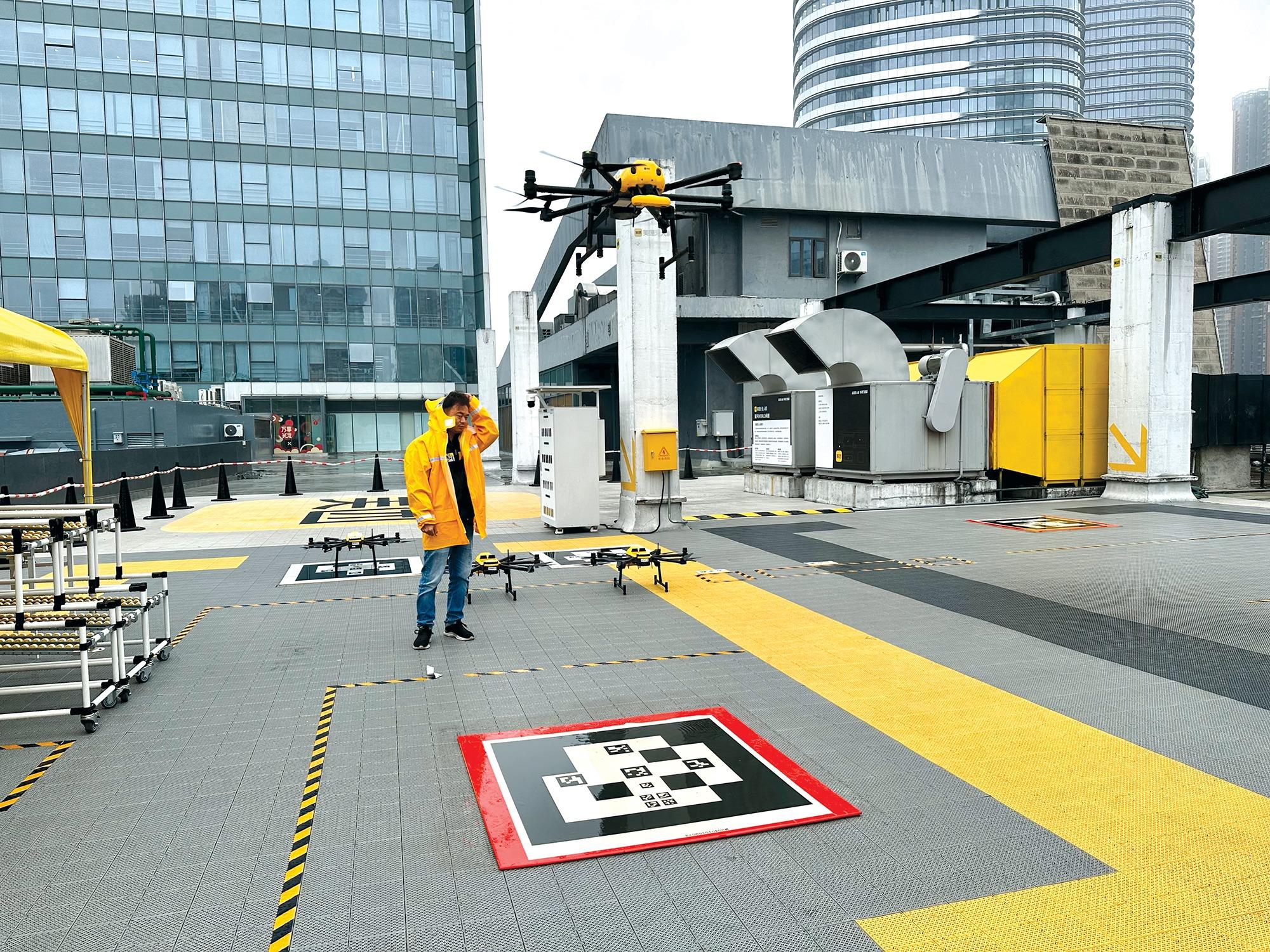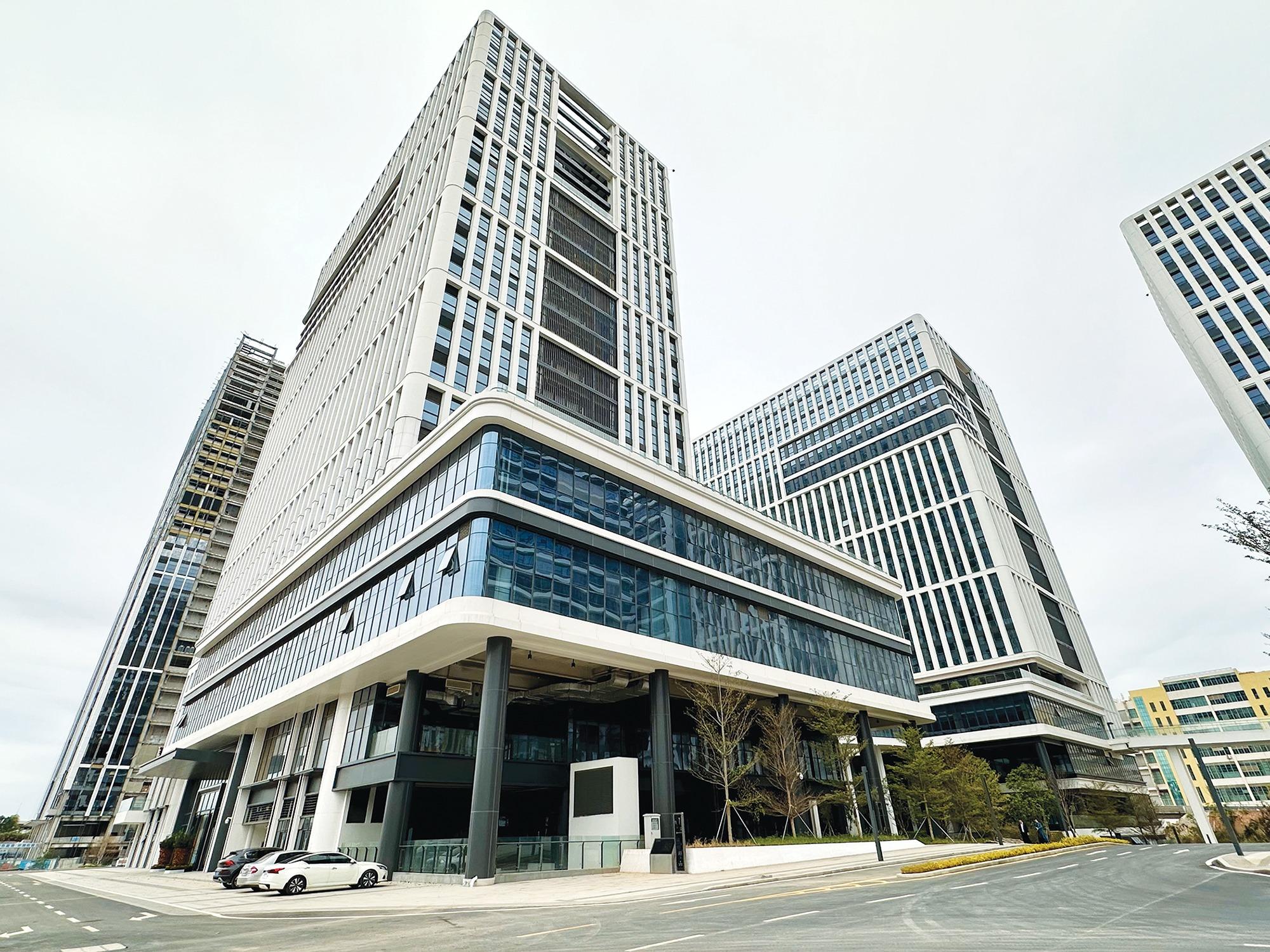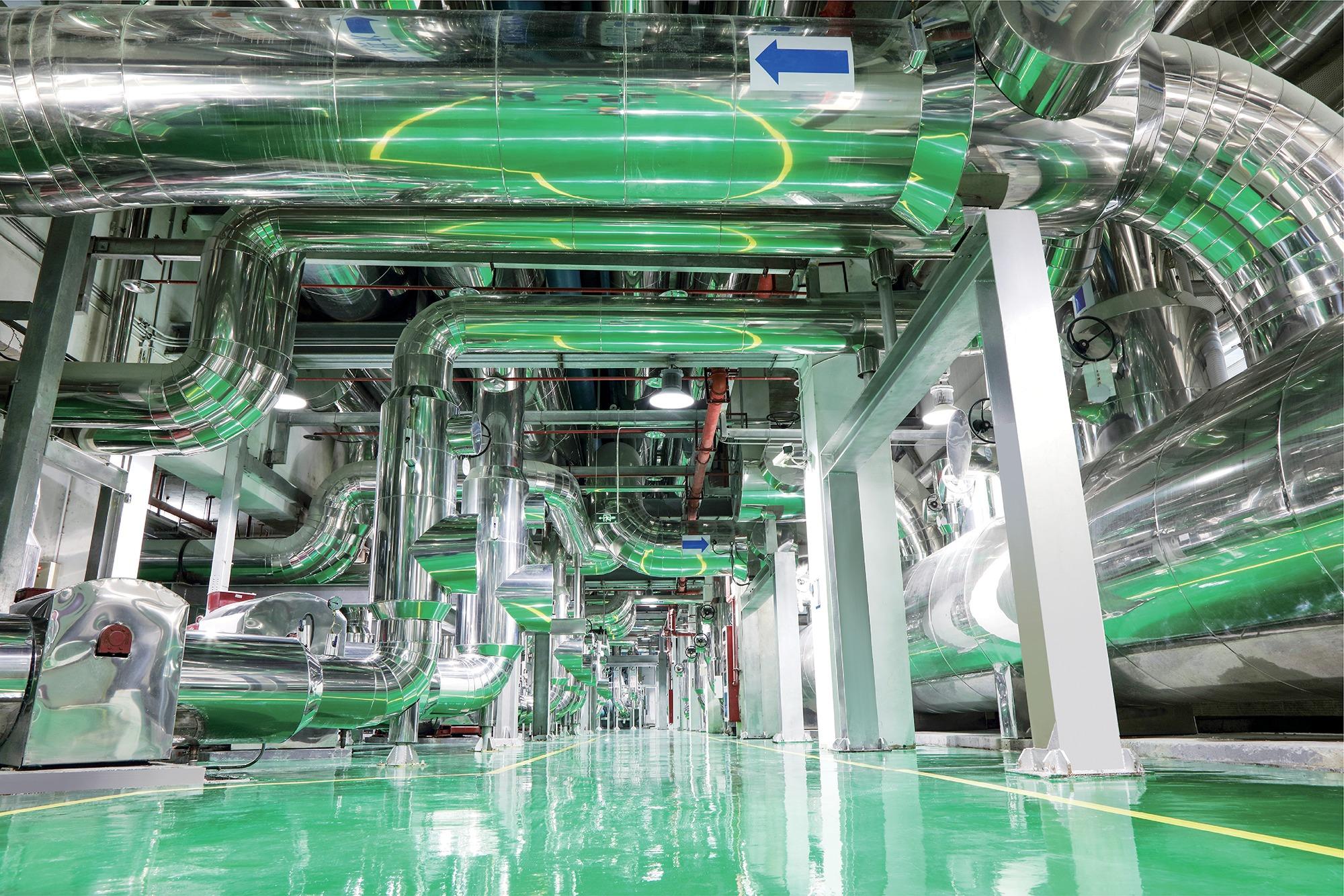Chinese mainland’s leading innovation-tech hub and one of the most successful special economic zones is expanding vertically and underground to deal with a booming economy and a growing scarcity of land. William Xu reports in Shenzhen.
 A Meituan worker packs food and drinks into a box designed for drone deliveries. (WILLIAM XU / CHINA DAILY)
A Meituan worker packs food and drinks into a box designed for drone deliveries. (WILLIAM XU / CHINA DAILY)
It was a foggy morning before the Lunar New Year in early February, with Zhang Youhui kept in suspense before the Shenzhen municipal authorities gave the green light for his drones to take off again.
Zhang is a manager overseeing deliveries of food, products and other supplies by drones at a commercial complex in the southern Chinese mainland city’s Longgang district. Working for Meituan — a technology-driven retail company in China — he heads an eight-member team that facilitates the operations of about 20 drones that transports food and drinks via the air to consumers.
READ MORE: Shenzhen to grow as hub of innovation
They had been informed earlier they had to suspend operations due to poor visibility. Zhang used the pause to examine his unmanned air delivery fleet. Free from the hazards caused by the terrain or traffic congestion, the mini-aircraft can travel up to 3 kilometers within 15 minutes, even during peak hours — a speed that’s difficult for vehicles to achieve on the roads.
 A drone in operation in Shenzhen. (WILLIAM XU / CHINA DAILY)
A drone in operation in Shenzhen. (WILLIAM XU / CHINA DAILY)
Meituan has established 23 delivery routes across some of Shenzhen’s busiest commercial areas for the past three years. The delivery giant’s ambitious move to leverage the potential of low-altitude airspace coincides with Shenzhen’s goal to become a “vertical city”.
“China’s Silicon Valley”, with a population of more than 17.6 million, has joined the ranks of land-starved cities like Hong Kong amid its breakneck pace of economic expansion. In its territorial spatial-master planning blueprint, unveiled in 2021, Shenzhen earmarked 1,190 square kilometers of land, or 59.6 percent of its total land area, for development, while the others would be strictly preserved for ecologic and agricultural use. So far, nearly 82 percent of the land set aside for development has been taken up, and no further space can be released to meet the city’s insatiable appetite for land.
This year marks the fifth anniversary of the publication of the Outline Development Plan for the Guangdong-Hong Kong-Macao Greater Bay Area, in which Shenzhen is entrusted to expedite its transformation into “a modern and international city”.
To achieve greater development with limited land resources, Shenzhen has set its sights on the sky and underground.
The city enacted the nation’s first local legislation last month to promote the low-altitude economy, referring to economic flying activities conducted by manned or unmanned vehicles operating below 1,000 meters. Currently, Shenzhen produces more than 70 percent of the world’s consumer drones, and the latest legislation has given the industry a shot in the arm.
 A Meituan employee oversees drone deliveries at a commercial complex in Shenzhen. (WILLIAM XU / CHINA DAILY)
A Meituan employee oversees drone deliveries at a commercial complex in Shenzhen. (WILLIAM XU / CHINA DAILY)
As soon as the nod for Meituan to resume its drone operations came through, Zhang immediately ordered his team back into action. His “airport” station — on an open platform on the Longgang mall’s fifth floor — was soon buzzing with activity again. Minutes later, an employee picked up two bottles of soft drinks ordered by clients from a shop downstairs.
Packing the drinks in a box specially designed for air transportation, another worker set a drone off after hooking the consignment to its bottom. The vehicle soon vanished into the air. Located at the terminus of the drone’s route is a parcel locker that’s nearest to the consumer’s address, explains Zhang. His team can make an average of up to 300 deliveries a day. Whether an order is assigned to a drone or a rider is determined by the system that judges the distance involved and traffic conditions at the time, he says.
Liu Shuo, head of Meituan’s commercial drone strategy unit, told China Daily that the unmanned air vehicles can easily fly over tunnels, bridges and other urban terrains that may take delivery workers on the ground a lot of time to navigate.
Shenzhen’s efforts to tap the low-attitude economy represent a move in the right direction as the city “opened more airspace for business use in the past few years, and simplified relevant applications,” she said.
Deliveries by drones, however, are still impeded by certain restrictions, such as not being allowed to take off in adverse weather conditions. Liu said she believes they’re still a good supplement to ground deliveries, adding that Meituan is also trying to use drones to transport medical and emergency supplies.
 The 22-floor research tower and the 19-story development building at Pingshan New Energy Vehicle Industrial Park. (WILLIAM XU / CHINA DAILY)
The 22-floor research tower and the 19-story development building at Pingshan New Energy Vehicle Industrial Park. (WILLIAM XU / CHINA DAILY)
Cooling underground
As the transportation business fights for more space in the sky, Shenzhen’s Qianhai economic development zone is mapping out a “super” urban underground project covering more than 600 hectares, including more than 130 hectares of commercial space and public passages, 9.8 kilometers of highways, and a six-level public transportation hub, as well as a district system supplying cool energy for skyscrapers in the region.
Shenzhen Qianhai Energy Technology Development Co built and operates the region’s district cooling system. At its No 5 cooling plant under a bus terminal, machines make ice at night — an off-peak electricity consumption period for commercial districts — and melt the ice during the day. The cold energy released when the ice melts will be collected to lower the temperature of water, which will be piped into users’ buildings to provide cold energy for their air conditioning systems.
Fu Jianping, director of Shenzhen Qianhai Energy Technology Development, says the district cooling system helps property owners save an average of 6 percent of floor area, as the property owners would not have to install an individual air conditioning system on their premises.
 The No 2 cooling plant in Qianhai, Shenzhen, operated by the Shenzhen Qianhai Energy Technology Development Co, is part of the district's underground centralized cooling system. (PROVIDED TO CHINA DAILY)
The No 2 cooling plant in Qianhai, Shenzhen, operated by the Shenzhen Qianhai Energy Technology Development Co, is part of the district's underground centralized cooling system. (PROVIDED TO CHINA DAILY)
Fu, who has been involved in building district cooling systems for decades, described Qianhai as the first new development zone on the mainland that incorporates a centralized air conditioning system at the beginning of its design.
Since the first district cooling plant—No.2 cooling plant was completed in 2016, Qianhai now has five cooling plants serving 52 commercial users, and covering an area of 350 hectares. The system is expected to reduce carbon emissions by about 15,000 metric tons annually, with its supply capacity accounting for more than 20 percent of the nation’s district energy market.
The economic zone’s experience of managing its cooling system has helped Shenzhen Qianhai Energy Technology Development to secure a market share of 13.4 percent in the country’s regional cooling energy industry and win the bid to operate the additional district cooling system at Hong Kong’s Kai Tak Development, which is due to be completed this year.
 An aerial view of the Additional District Cooling System at the Kai Tak Development. It uses chilled water as a cooling medium, and will come into full operation this year. (PROVIDED TO CHINA DAILY)
An aerial view of the Additional District Cooling System at the Kai Tak Development. It uses chilled water as a cooling medium, and will come into full operation this year. (PROVIDED TO CHINA DAILY)
Higher-end plants
Shenzhen is also relocating small and midsize factories to high-rise buildings to free up more land for development. Sitting on the boundary between Shenzhen and Huizhou in Guangdong province, the Pingshan New Energy Vehicle Industrial Park is a benchmark project demonstrating how “upstairs factories” work.
The park’s first phase, which has been completed, has a 17-floor industrial tower. Cargo vehicles can enter the building’s first three floors through side roads, while four cargo elevators can carry trucks from the fourth to the 17th floors. There’re also a 22-story building for research purposes, and a 19-story development tower in the park. The latter two buildings house canteens, banks and shops on their lower floors, offices and laboratories on the middle floors, and dormitories on the upper levels.
With a vertical design, the park takes up a total land area of almost 110,000 square meters. It can provide more than 320,000 square meters for industrial and R&D purposes, and is capable of accommodating 80 to 100 small and midsize factories, according to Lu Donghe, deputy general manager of the park’s operator Shenzhen Pingshan District Industrial Investment Service Co.
ALSO READ: Air taxi eVTOL completes 1st flight in China
Apart from saving land, Lu believes housing companies from the same supply chain in one building can boost productivity. “Companies may find that products they need can be developed or produced by other enterprises, and they can easily interact with each other.” The three buildings have also reinforced their floors to withstand heavier equipment and the vibrations produced.
Completed in mid-2023, the industrial park will welcome the first factory to be set up there in a few months. The park’s 36,900-square-meter second phase is under construction, with a 6,600-square-meter single-floor laboratory and an industrial tower designed for the use of the Shenzhen Automotive Research Institute of the Beijing Institute of Technology.
Shenzhen launched a five-year plan in 2022 to promote the building of “upstairs factories”, vowing to provide over 2,000 hectares of high-quality, low-rent and customized industrial space annually. More than 72 such projects across the city have been completed so far.
Last month, the low-altitude economy also saw an “air taxi” — an electric vertical take-off and landing aircraft — complete a trial intercity flight from Shenzhen to Zhuhai in 20 minutes, testifying to Shenzhen’s resolve to develop the sector.
A 200,000-square-meter underground integrated transportation hub is also taking shape in Qianhai, aimed at linking the economic zone with the rest of the Greater Bay Area by three metro lines and an intercity railway.
Contact the writer at williamxu@chinadailyhk.com


